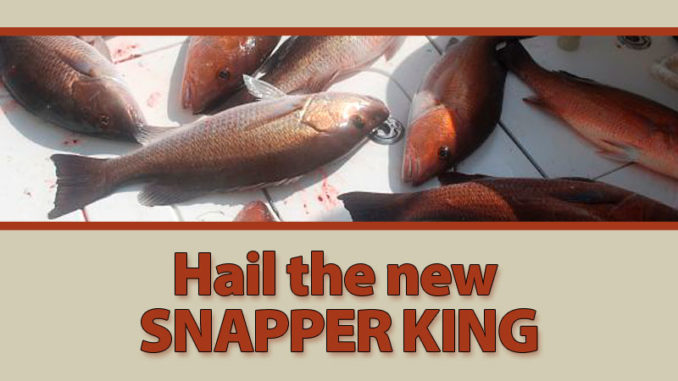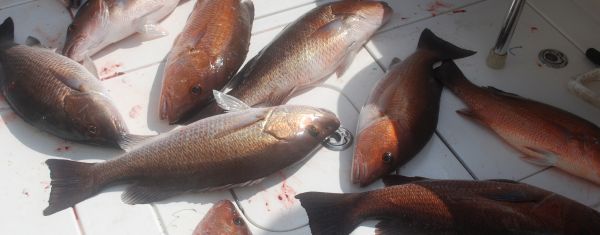
Mangroves replace over-regulated red snapper
Let’s face it: The red snapper is no longer the king.
Once, he ruled the Gulf of Mexico. During the 1950s and 1960s, when recreational fishermen forayed offshore it was for the red snapper. Oh sure, a small clique of big-game anglers trolled for billfish (some of which — yikes — were even eaten in those days) and tuna.
Tuna were considered inedible, mainly because we ate them in the form of sawdust — produced by frying them to well-done like we did everything else with fins.
King mackerel were rodeo fish: caught, weighed and discarded. Amberjacks were not even that popular; they were simply trash fish.
Everyone knew that the only offshore fish fit to fish for were red snappers, cobia (invariably called ling or lemonfish) and — at nearshore rigs during the winter — pompano.
Red snapper
The red snapper was the king, the cobia the queen and the pompano the prince of fishes.
 Then along came the 1990s and red snappers became a fisheries management football — a poster child for conflict.
Then along came the 1990s and red snappers became a fisheries management football — a poster child for conflict.
More than sport and commercial fishermen were involved. Environmental organizations showed up, determined to achieve recognition as being as big a stakeholder as the two groups of fishermen.
The National Marine Fisheries Service (NOAA Fisheries) pulled a big stick from behind its back. They were hard-bent to prove that they had the answers and the muscles to flex their management stick.
Stunned anglers watched as two-fish limits and 27-day seasons, followed by nine-day seasons, were imposed. They were told, to make a long story short, that they needed smaller limits and shorter seasons because the red snapper population was doing better.
The stance that you need more restrictions when the snapper population goes down, and when the fish population goes up you need even more restrictions left fishermen mystified and searching for an alternative.
Mangrove snapper
The alternative has been there all along, as it turns out, in the gray snapper — usually called the mangrove snapper and occasionally the mango or black snapper by Louisianans.
My introduction to the fish came through conversations in the early 1970s with the late Warren “Whip” Mermilliod, a fellow biologist and a fanatical member of the Hell Divers Spearfishing Club.

He described them as brainiacs, the smartest fish under the oil platforms off our coast. The legs of a platform would be swarming with them, but as soon as the first diver shot the first mangrove snapper, no one else could get near enough to another one for a shot.
Red snappers were dunces compared to mangroves, said Mermilliod, and jewfish (now in all political correctitude renamed as “goliath grouper”) were even less wary than red snappers — probably the reason that they were all shot out by the 1990s.
The mangrove snapper is one of 14 Gulf of Mexico members of Lutjanidae, the snapper family. The species carries the scientific name of Lutjanus griseus. The fish was given its scientific name in 1758 by Carl Linaeus, the Swedish scientist who invented the method we still use to name animals and plants today.
Linaeus was usually very descriptive in assigning scientific names, but in spite of that, I can find no record in either Latin or Greek of what the word “Lutjanus” means. The second part of the name, “griseus,” is easy: It means “gray” in Latin.
Color
Color is not a good way to identify this fish because of its notoriously variability, especially in smaller sizes. Many of them, especially offshore and most especially larger fish, are anything but gray, being so heavily pigmented that they appear to be brick red.
In this coloration, they closely resemble cubera snapper, the giant of the family that can reach 100 pounds.
Besides the fact that few mangrove snappers grow over 15 pounds in weight, the best way to separate the two species is by checking their teeth.
Cubera snappers are dedicated fish-eaters and have a mouth full of dog-like canine teeth. If an angler is still in doubt, a quick check of the patch of easy-to-find small vomerine teeth on the roof of the mouth will tell the tale. The patch is v-shaped in the cubera, but v-shaped with a shaft (like an arrow shaft and head) in the mangrove.
When exhibiting their gray color, noticeable vertical bars are displayed on their sides. Even fish predominantly gray will show a noticeable reddish dot on each scale on the lower halves of their sides.
The gray color, vertical barring and the fact that they aren’t where fishermen would expect them to be lead most anglers to overlook them when they find them inshore. Mangrove snappers range much farther into low-salinity estuaries than any other snapper species.
Size
Small fish, 2 to 3 inches long, are very common miles inland, and often turn up in shrimp trawl catches from which they are tossed back overboard as “some kind of perch.” These little guys are quite attractive, with distinctive vertical bars on their body, a dark bar running diagonally downward through each eye and an electric-blue line on each cheek.
They retain these blue or blue-green lines on their faces until they are 10 to 11 inches long —the entire time that they live inshore in bays and lakes. At that size they are willing feeders, and will quickly take a baited hook.
Some anglers keep them, not realizing what they are and that they have a minimum length of 12 inches.


